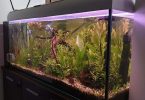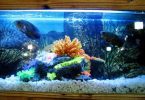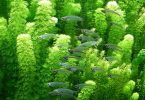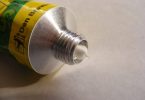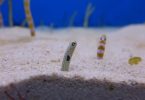Table of Contents
Goldfish Tank Mates
Goldfish is one of the many types of fancy fish. These varieties of fish have been bred for their unique fins, patterns of color and shaped eyes and head.
Most aquarists want to have more than one fish in their tank for their gold fish but the truth is, not all will be the perfect fit for goldfish tank mates.
Every type of fish has different needs, in fact not all goldfish are compatible. For example, some fish live better in warm water, some like salt water while others prefer cold water.
Because you will want all your fish to be healthy and happy, it is important to choose tank mates who like the same tank conditions as with your fish.
Tank conditions for fish living with gold fish.
There are several factors that may influence a fish’s ability to adapt to other species.
Goldfish has some specificity that removes many common favorites, so you definitely need to check before finding a tank mate for your goldies. The main considerations for selecting Goldfish tank mates are:
-
Water temperature
First of all, goldfish are cool water fish. Many of the most popular pet fish are tropical fish, however, which means they won’t do as well in the same fish tank as your goldfish.
Either the water will be too cold for the tropical fish or the water will be too warm for your gold fish.
Goldfish require temperatures between 68 and 74-degrees Fahrenheit, depending on the season. Tropical fish require 75 to 80 degrees Fahrenheit.
Cold water can cause harm to the health of tropical fish’s very important you put this into consideration when selecting goldfish tank mates.
-
Size
Goldfish are omnivores and that means they will eat any fish small enough to get into their mouths. Neon Tetras, Guppies, and other small and other smaller fish too.
When your goldies are small, this is not a big deal. But as they grow older, they will begin to take the bites of other fish in the tank.
It is important to make sure that you check compatibility before making a selection for your goldfish tank mates. It is therefore best to go with the fish at least 3-4 inches (7.5-10 inches).
-
Temperament
Goldfish are peaceful fish with a low-key personality. And they are often bullied by other fish which cause a lot of stress to them and also physical harm as well, unless they are housed with the appropriate tank mates.
Some species are known as predators, such as tetra species, convict cichlids, jack Dempsey’s and tiger barbs. They absolutely can’t be accommodated in the same tank with your goldfish.
The Safe and compatible goldfish tank mates:
1. Rosy barbs
- Scientific name: Pethia conchonius
- Origin: South Asia · Size: 4 inches · Attitude: peace (should be kept in a group of 5 or more)
- Size: 6 inches (15 centimeters)
- Food: omnivore
- Minimum tank size: 113 liters (113 liters)
Rosy Barbs is one of the most popular barbs in the family and is relatively peaceful compared to the aggressive tiger barb. Being kept alone or in a small group can make them become aggressive.
The bigger the group, the more likely they are to just concern themselves with each other rather than the goldies.
Rosy barbs are fast swimmers, be sure that your gold fish get some food before rosy barbs swoop in. They are about 6 inches, that’s a great size, you won’t have issues with your goldfish eating it that’s way too big for them which makes them a perfect fit for goldfish tank mates.
Rosy Barbs adapts to different water conditions but prefers low pH alkaline (6.0-8.0) and subtropical to moderate temperatures (67-74F).
2. Zebra Danios (Danio Rerio)
- Level of care: easy
- Attitude: peace (needs to be kept in a group of 5 or more)
- Size: 2 inches · minimum l tank size: 38 liters
Zebra danios are small fish with blue and yellow stripes running from the nose to the tail. Their bodies are covered with a glittering iridescent sheen that shimmers.
Zebra danios are fast- moving, little fish that can easily tolerate the same temperature as goldfish. Note, they are small enough for your goldfish to eat.
However, they are faster swimmers than most goldfish. It is dangerous to mix these two species, but danios can become very fast and can easily outswim a goldfish.
When keeping them with a goldfish, it would be a good idea to provide danios with some tall artificial plants so that they have a place to hide if needed.
3. Giant Danios (Devario Aequipinnatus)
- Level of care: easy
- Attitude: peace (should be kept in a group of 5 or more)
- Size: 4 inches
- Omnivore
- Minimum tank size: 113 liters
They look similar to the zebra dainos, with blue and yellow stripes running down their bodies, but twice as big as zebras. They are also meant to be kept together in a group of more than five or more.
If their group is too small, they may be more stressed and aggressive.
It is a good idea to provide them with tall artificial plants so that they can have a hiding place if needed. Giant danios can outswim goldfish easily, so be sure the danios don’t outcompete them for food.
4. White cloud mountain minnows
As an aquarist, if you like to keep just the goldfish in your tank, then you could consider the mountain minnows, because they are quite affordable to keep and always like to be in a group, and grow to only about one point five inches to two inches in its length.
After purchase, they are usually small in size, it is advisable to grow them separately before placing them in the tank with the goldfish.
More so, they can easily be eaten by the goldfish but they are much faster than a gold fish and difficult to catch.
There are many different types of white cloud minnows (such as the gold or normal species), but do not purchase the ones with long fins, as the length of their fins reduces their speed and makes them prone to being preyed upon.
5. Japanese Rice Fish
This species of fish is also known as the medaka. It is a beautiful species that can thrive in the fresh water tank.
It is about one point six inches long, it is white in colour with a soft yellow blend in its body. The Japanese rice fish prefer to be in groups of about ten or more company.
They thrive in the atmosphere of about sixty-four degrees to seventy-two degrees Fahrenheit.
6. Platy (Xiphophorus Maculatus)
- Level of care: easy
- Climate: peaceful (should be in a ratio of two females to a male)
- Size: 2.5 inches
- Omnivore
- Minimum tank size: 38 liters
Platies are often considered tropical fishes but they can thrive in the low 70 temperature along with goldfish.
They have small bodies with a wide variety of patterns and colors. And are livebearers, which means they give birth to live fry instead of laying eggs which will breed easily in water.
However, older platy fish and also gold fish tend to eat their fry unless they are transferred to a different tank.
Provide some hiding places with artificial plants and other decorations to give them a refuge from the goldfish when they need.
Platies are voracious eaters and fast swimmers, so be sure the platies don’t outcompete them for food.
7. Corydoras Catfish
These species are bottom scavengers, and are very peaceful. The fish comes in different sizes, say between one to about three inches length, and are usually part of the aquarium community.
They are also recommendable tank mates for the goldfish, so to have the gold fish ignore or neglect them, you will have to create a lot of places for them to hide in the aquarium.
8. Bristlenose pleco
This specie although controversial can still be considered a suitable tank mate for the goldfish, because in reality it is seen that this is mostly due to large plecos not getting enough food.
If you keep small varieties such as the bristlenose pleco, then the controversy may not arise as it is easier to manage these species.
9. Mysterious snails
- Size 5.9-inch wide
- Tank size: 10+ gallons
- Omnivore
- Level of care:
Easy Mysterious snails, also known as apple snails, are an easy-to-care animal that will get along well with your gold fish.
Both their size and their shell keep them safe from the nosy gold fish, although at first, they may be bothered by the gold fish curious to see if the snails can make a good meal.
As soon as the goldfish knows it can’t eat the snails, they will leave them alone. They will do very well in the same tank of goldfish and remain more active, and they can survive in cool water, if needed.
10. Reticulated Hillstream Loach
Reticulated Hillstream Loaches are of the South American family (origin: Vietnam and Laos) plecostomus.
They are about 2 to 3 inches in size, they use their flat bodies and their suction fins to attach to rocks, eating algae, tiny invertebrates, and microbial biofilms.
In fish tank, they should be stored in planted tanks rich in both algae and biofilms.
There are many species of loaches, many which are tropical. However, Reticulated Hillstream Loaches, no doubt the most attractive varieties, need cooler conditions and rich oxygen-rich water to thrive.
The 65-70F is best but not more than 75F, making them the fantastic tankmates for your goldfish.
11. Weather loaches
- Level of care: Easy
- Maximum size: 12 inches
- Temperament: Peaceful
- Water temperature: 40-77 ° F
- Water PH: about six point zero to eight point zero
- Minimum size of Tank: about twenty gallons
They are also known as pond loaches, is a fish known for its fascinating behavior, which scientists often use them to predict climate change and even natural disasters. This gifted fish is also a type of cold water that has no problem living in the same fish tank as a goldfish.
The weather loaches have a peaceful and easy-to-maintain condition, making it an excellent companion, and great for beginner fish owners.
Like all other schooling fish, weather loaches prefer to be among their own species, and should be kept in groups of at least 3 or more.
It is important to provide a larger tank that has enough space for them and your goldfish because they can grow up to 12.
Also, the popular loneliness of loach weather is boring, so a supply of sand or gravel substrate is recommended to keep them happy and free from stress.
12. Corydoras Catfish
This species is made up of a group of about one hundred little depth dwellers, they are scavengers, and are very peaceful.
The fish comes in different sizes, say between one to about three inches length, and are usually part of the aquarium community.
They are also recommendable tank mates for the goldfish aquarium because it is has a tail tends to be quite big for feed, the dwarf Corys precisely, so to have the gold fish ignore or neglect them, you will have to create a lot of places for them to hide in the aquarium. More so, there may be changes in the temperature based on what they choose.
13. Gold Barb
Gold Barbs is relatively moderate compared to Rosy, Zebra, Tinfoil, and other bigger species and more peaceful.
They will happily eat prepared flakes and pellets but should be given legumes and soft aquatic plants sometimes as a treat.
Gold Barbs are eye-catching naturally. They can be kept alone or in small groups of three to six. Gold barb fish are fast swimmers that busily root around in the substrate alongside Goldfish!
14. Ghost and Cherry Shrimp
Shrimp is another that can do well with a gold fish, most especially red cherry shrimp or ghost shrimp. Ghost shrimp are small and often sold as food for other fish.
They can be an interesting addition to any tank and will not cause any harm to the gold fish. Red cherry shrimp are a good choice because they are algae eaters and can help keep your tank clean.
When keeping shrimp in the tank with your goldfish, be sure to include caves and more ornaments. This gives them a place to hide and helps them to live as long as possible.
15. Rubbernose pleco
The outstanding thing about this specie is its funny name, and it is also called the bulldog or the rubber lip. It also is similar to the bristlenose but it has no single bristle.
However, they require similar treatments and care with the bristlenose, and they equally grow up to about five to six inches. They are algae eaters and are quite peaceful.
16. Paradise fish
Paradise Fish was one of the first tropical fish to be introduced into the industry.
They are not popular these days but are always inexpensive, hardy choices for tropical and cold-water setups. Paradise Fish needs careful consideration because it is territorial and aggressive.
They should never be kept with Goldfish in an aquarium with a size of less than 30 gallons of water as Goldfish swims slowly and will be mercilessly bullied.
Like most Gouramis Paradise Fish are carnivores, they prefer to eat small invertebrates such as Daphnia, Bloodworms, and Tubifex. However, they have been tank bred for decades and easily take prepared flakes and small pellets.
17. Angelfish
Angelfish are great fit goldfish tank mates because they contrast in many ways. Goldfish are thick-bodied and Angelfish are tall, elegant in shape, and come in a variety of black and silver rather than gold and red.
They both happily accept pellets, flakes and frozen foods. The ideal temperature required for them should be kept at about 75F for both types to be comfortable. Angelfish also prefer a less acidic water (pH 6.0-7.0).
18. Gouramis
The Gourami range ranges from 2 inch Dwarf and Honey Gouramis to 3 foot monster Giant Gourami. They are all found in South and East Asia, they are partial air breathers and breathe in partially because they are found in stagnant or slow- moving water.
Bettas and Paradise Fish belong to the same family and can be considered a Gourami species.
Both are also a partial respiratory tract and like many Gourami, they form bubble nests to enlarge the eggs and fry inside.
Some of the best goldfish tank mates include the large but peaceful Pearl, Moonlight Gouramis and the brightly colored Dwarf Gourami for smaller community aquariums.
19. Murray Rainbow River Fish
This colorful silver, blue is mostly found in the Murray River of Australia, and is usually about four inches.
They have amazing colours and can survive a variety of temperature. Interestingly, they are also stored within seventy-five liter tanks and are good tank mates for small gold fish.
20. Scissortail rasbora
This specie also can make a good tank mate for the gold fish. It is a silver fish with marks of black spots on its tail and body, and is about six inches long. They feed on fresh blood worms, flakes and pellets.
Conclusion
It is not easy to setup an aquarium tank around a goldfish but, with careful planning, it can be done. A well-planned combination of fish in the right place can make an effective aquarium fun to watch.


